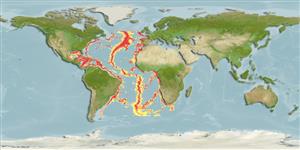Teleostei (teleosts) >
Alepocephaliformes (Slickheads and tubeshoulders.) >
Alepocephalidae (Slickheads)
Etymology: Alepocephalus: Greek, alepos, alepidotos = without scales + Greek, kephale = head (Ref. 45335).
More on author: Gill.
Environment: milieu / climate zone / depth range / distribution range
Ecology
Marine; bathydemersal; depth range 815 - 3500 m (Ref. 27363). Deep-water; 53°N - 49°S, 180°W - 180°E
Possibly circumglobal. Eastern Atlantic: off southwestern Ireland, and Morocco. Western Atlantic: two localities (20° and 39°N). One specimen from the Patagonian region of Argentina (Ref. 27363). Possibly in the Western Central Pacific (38717).
Size / Weight / Age
Maturity: Lm ? range ? - ? cm
Max length : 41.0 cm SL male/unsexed; (Ref. 27363)
Short description
Identification keys | Morphology | Morphometrics
Found over soft bottoms (Ref. 27363). Maximum length based on a single specimen (Ref. 27363).
Life cycle and mating behavior
Maturity | Reproduction | Spawning | Eggs | Fecundity | Larvae
Markle, D.F. and J.-C. Quéro, 1984. Alepocephalidae (including Bathylaconidae, Bathyprionidae). p. 228-253. In P.J.P. Whitehead, M.-L. Bauchot, J.-C. Hureau, J. Nielsen and E. Tortonese (eds.) Fishes of the North-eastern Atlantic and the Mediterranean. UNESCO, Paris. Vol. 1. (Ref. 4736)
IUCN Red List Status (Ref. 130435: Version 2024-1)
Threat to humans
Harmless
Human uses
Fisheries: of no interest
Tools
Special reports
Download XML
Internet sources
Estimates based on models
Preferred temperature (Ref.
123201): 3.2 - 4.9, mean 4 °C (based on 537 cells).
Phylogenetic diversity index (Ref.
82804): PD
50 = 0.5000 [Uniqueness, from 0.5 = low to 2.0 = high].
Bayesian length-weight: a=0.00347 (0.00163 - 0.00737), b=3.19 (3.00 - 3.38), in cm total length, based on LWR estimates for this (Sub)family-body shape (Ref.
93245).
Trophic level (Ref.
69278): 3.6 ±0.2 se; based on size and trophs of closest relatives
Resilience (Ref.
120179): Medium, minimum population doubling time 1.4 - 4.4 years (Preliminary K or Fecundity.).
Fishing Vulnerability (Ref.
59153): Moderate vulnerability (40 of 100).
Nutrients (Ref.
124155): Calcium = 15.8 [4.2, 59.6] mg/100g; Iron = 0.48 [0.17, 1.19] mg/100g; Protein = 11.4 [9.4, 14.5] %; Omega3 = 0.34 [0.13, 0.91] g/100g; Selenium = 17.1 [5.2, 57.7] μg/100g; VitaminA = 17.7 [3.8, 85.0] μg/100g; Zinc = 0.369 [0.188, 0.746] mg/100g (wet weight);
